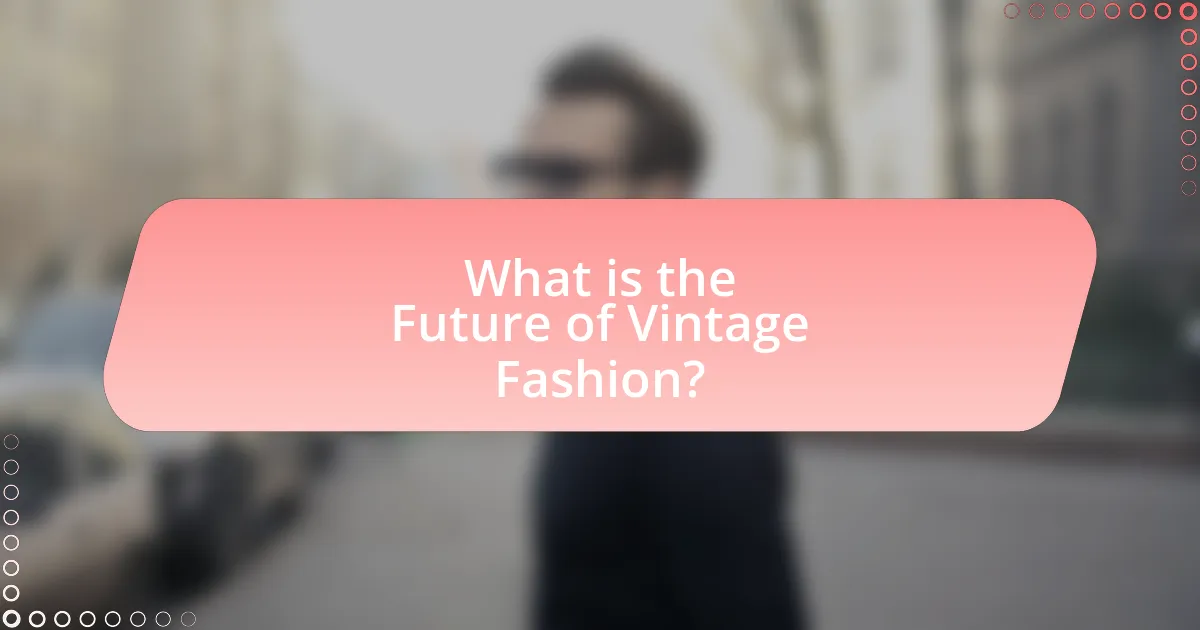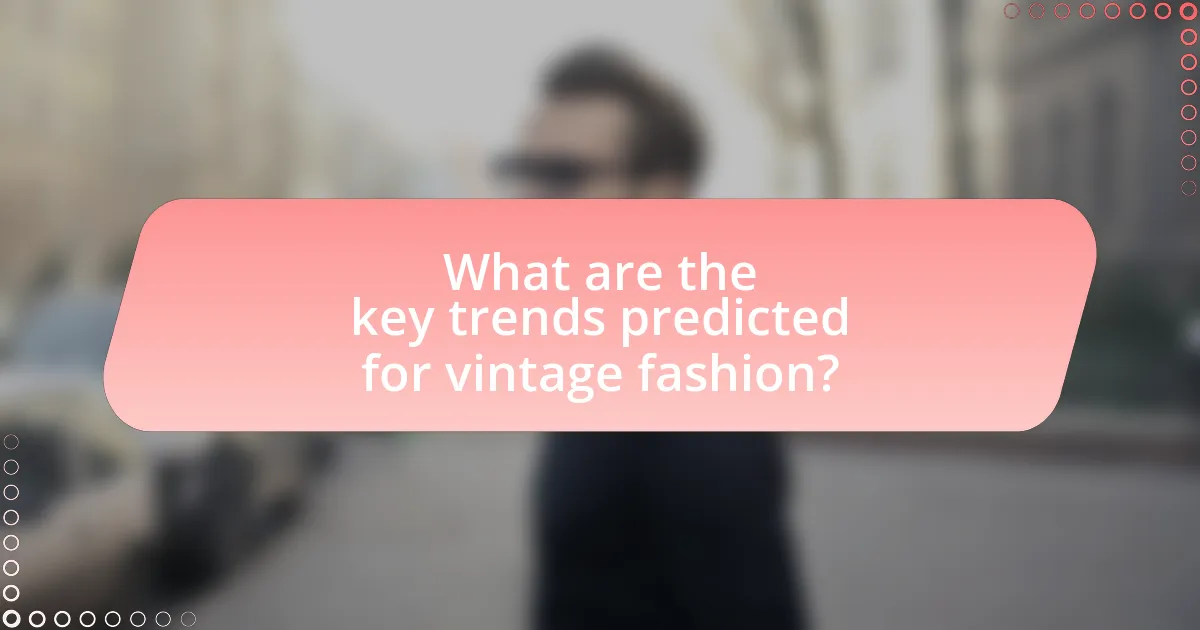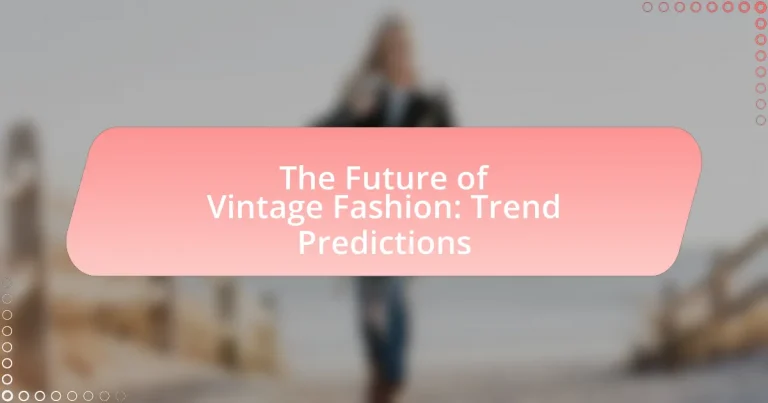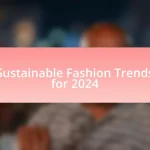The article focuses on the future of vintage fashion, highlighting its increasing popularity driven by sustainability and individuality. It discusses how vintage clothing serves as an eco-friendly alternative to fast fashion, with the secondhand market projected to reach $64 billion by 2024. Key trends include the resurgence of styles from the 1990s and early 2000s, the influence of social media and cultural movements, and innovations in fabric and design. Additionally, the article outlines best practices for sourcing and styling vintage items, emphasizing the importance of ethical shopping and consumer engagement in promoting sustainable fashion practices.

What is the Future of Vintage Fashion?
The future of vintage fashion is characterized by a growing emphasis on sustainability and individuality. As consumers increasingly prioritize eco-friendly practices, vintage clothing offers a sustainable alternative to fast fashion, reducing waste and promoting circularity in the fashion industry. According to a report by ThredUp, the secondhand market is projected to reach $64 billion by 2024, indicating a significant shift towards vintage and pre-owned apparel. This trend is further fueled by the rise of social media platforms, where vintage styles are showcased, creating a sense of community and encouraging unique personal expression.
How is vintage fashion defined in contemporary contexts?
Vintage fashion in contemporary contexts is defined as clothing and accessories that originate from previous decades, typically ranging from the 1920s to the 1990s, which are appreciated for their unique styles, craftsmanship, and cultural significance. This definition is reinforced by the growing popularity of sustainable fashion practices, where vintage items are sought after as eco-friendly alternatives to fast fashion, reflecting a shift in consumer values towards sustainability and individuality. Additionally, vintage fashion is often characterized by its nostalgic appeal, as it allows individuals to express personal style while connecting with historical trends, thus making it a significant aspect of modern fashion culture.
What historical influences shape current vintage fashion trends?
Current vintage fashion trends are shaped by historical influences such as the 1920s flapper movement, the 1960s counterculture, and the 1980s power dressing. The flapper era introduced a shift towards more liberated styles, emphasizing shorter hemlines and boyish silhouettes, which continue to inspire modern designs. The 1960s brought about bold patterns and vibrant colors, reflecting social change and youth culture, elements that are frequently revisited in contemporary fashion. Additionally, the 1980s power dressing, characterized by oversized silhouettes and strong shoulder pads, has seen a resurgence as a symbol of empowerment and individuality. These historical influences are evident in current collections, where designers often draw upon past aesthetics to create nostalgic yet innovative pieces.
How do cultural movements impact the perception of vintage fashion?
Cultural movements significantly shape the perception of vintage fashion by influencing societal values, aesthetics, and consumer behavior. For instance, the rise of sustainability movements has led to a greater appreciation for vintage clothing as an eco-friendly alternative to fast fashion, with studies indicating that 66% of consumers consider sustainability when making fashion choices. Additionally, movements such as retro revival and nostalgia culture have made vintage styles more desirable, as seen in the resurgence of 90s fashion trends in contemporary collections. This interplay between cultural movements and vintage fashion not only enhances its appeal but also drives market demand, as evidenced by the increasing sales of second-hand clothing, which reached $36 billion in 2021.
Why is vintage fashion gaining popularity?
Vintage fashion is gaining popularity due to a growing consumer preference for sustainability and individuality in clothing choices. As awareness of fast fashion’s environmental impact increases, many consumers are turning to vintage options as a more eco-friendly alternative. According to a 2021 report by ThredUp, the secondhand market is projected to reach $64 billion by 2024, indicating a significant shift towards pre-owned clothing. Additionally, vintage fashion allows individuals to express unique personal styles, setting them apart from mass-produced items. This combination of sustainability and self-expression is driving the resurgence of interest in vintage clothing.
What role does sustainability play in the rise of vintage fashion?
Sustainability significantly drives the rise of vintage fashion by promoting environmentally friendly practices and reducing waste. The fashion industry is one of the largest polluters globally, with the production of new clothing contributing to excessive resource consumption and landfill overflow. Vintage fashion offers a solution by encouraging the reuse of garments, thereby minimizing the demand for new production and its associated environmental impact. According to a report by the Ellen MacArthur Foundation, extending the life of clothing by just nine months can reduce carbon, water, and waste footprints by 20-30%. This growing awareness of sustainability among consumers has led to an increased interest in vintage clothing, as individuals seek to make more responsible fashion choices.
How do social media and influencers affect vintage fashion trends?
Social media and influencers significantly shape vintage fashion trends by amplifying visibility and accessibility. Platforms like Instagram and TikTok allow influencers to showcase vintage styles, making them appealing to a broader audience. For instance, a study by the Fashion Institute of Technology found that 70% of consumers are influenced by social media when making fashion purchases, highlighting the power of these platforms in driving trends. Additionally, influencers often curate vintage outfits, creating a sense of authenticity and nostalgia that resonates with their followers, further promoting the resurgence of vintage styles.

What are the key trends predicted for vintage fashion?
Key trends predicted for vintage fashion include a resurgence of 90s and early 2000s styles, increased sustainability through upcycling and thrift shopping, and a focus on unique, one-of-a-kind pieces. The popularity of 90s and early 2000s fashion is evidenced by the revival of items like baggy jeans, crop tops, and oversized jackets, which have been embraced by contemporary designers and influencers. Sustainability is becoming a priority, with consumers increasingly opting for second-hand clothing to reduce waste, as reported by the Global Fashion Agenda’s 2021 Pulse of the Fashion Industry report, which highlights a growing shift towards eco-conscious purchasing. Additionally, the demand for unique vintage items is rising, as shoppers seek to express individuality in a market saturated with fast fashion.
How will technology influence vintage fashion in the future?
Technology will significantly influence vintage fashion in the future by enhancing design processes, improving sustainability, and facilitating personalized shopping experiences. Advanced technologies such as 3D printing and artificial intelligence will allow designers to recreate vintage styles with precision and efficiency, making it easier to produce high-quality replicas. Additionally, sustainable practices will be bolstered by innovations in fabric recycling and eco-friendly materials, addressing environmental concerns associated with fast fashion. Furthermore, augmented reality and virtual fitting rooms will enable consumers to try on vintage pieces digitally, enhancing the shopping experience and increasing accessibility to vintage fashion. These technological advancements will not only preserve the essence of vintage fashion but also adapt it to modern consumer needs.
What innovations in fabric and design are emerging in vintage fashion?
Innovations in fabric and design emerging in vintage fashion include the use of sustainable materials, such as organic cotton and recycled polyester, alongside advanced textile technologies like digital printing and 3D knitting. Sustainable materials are gaining traction as consumers increasingly prioritize eco-friendly options, with the global organic cotton market projected to grow significantly, reflecting a shift towards environmentally responsible fashion. Digital printing allows for intricate designs that mimic vintage aesthetics while reducing waste, and 3D knitting enables the creation of unique, customizable pieces that pay homage to vintage styles. These innovations not only enhance the aesthetic appeal of vintage fashion but also align with contemporary values of sustainability and personalization.
How are online platforms changing the way vintage fashion is accessed?
Online platforms are revolutionizing access to vintage fashion by providing a global marketplace that connects buyers and sellers, thus increasing availability and variety. These platforms, such as Etsy and Depop, enable users to browse extensive collections of vintage items from different eras and styles, which were previously limited to local thrift stores or physical boutiques. According to a report by ThredUp, the online resale market is projected to reach $64 billion by 2024, highlighting the growing consumer interest in second-hand and vintage clothing. This shift not only democratizes access to unique fashion pieces but also fosters a sustainable approach to shopping, as consumers increasingly seek eco-friendly alternatives to fast fashion.
What styles are expected to dominate vintage fashion in the coming years?
Retro styles from the 1970s and 1990s are expected to dominate vintage fashion in the coming years. The resurgence of these decades is driven by a growing interest in sustainability and nostalgia, as consumers increasingly seek unique, pre-owned clothing. According to a report by ThredUp, the secondhand market is projected to reach $64 billion by 2024, indicating a strong trend towards vintage shopping. Additionally, fashion influencers and celebrities are frequently seen wearing pieces inspired by these eras, further solidifying their popularity in contemporary fashion.
Which specific decades are likely to see a resurgence in popularity?
The 1990s and 2000s are likely to see a resurgence in popularity. This prediction is supported by the increasing influence of nostalgia-driven fashion trends, as evidenced by the revival of styles such as baggy jeans, crop tops, and platform shoes that were iconic during these decades. Additionally, fashion brands and designers are increasingly referencing these eras in their collections, indicating a broader cultural shift towards embracing past aesthetics. The popularity of 90s and early 2000s music and media further reinforces this trend, as younger generations seek to connect with the cultural touchstones of those decades.
How do current fashion cycles influence vintage style predictions?
Current fashion cycles significantly influence vintage style predictions by creating a cyclical nature in trends where past styles are revisited and reinterpreted. For instance, the resurgence of 1990s aesthetics in contemporary fashion, evidenced by brands like Balenciaga and Gucci incorporating elements from that era, demonstrates how designers draw inspiration from previous decades. This cyclical trend is supported by the “20-year rule,” which suggests that styles tend to re-emerge approximately every two decades, as seen with the revival of Y2K fashion in the early 2020s. Thus, the analysis of current fashion cycles allows forecasters to predict which vintage styles will gain popularity based on historical patterns and consumer behavior.

How can consumers engage with the future of vintage fashion?
Consumers can engage with the future of vintage fashion by actively participating in sustainable shopping practices, such as purchasing from thrift stores, online vintage marketplaces, and clothing swaps. This engagement not only supports eco-friendly fashion but also promotes the circular economy, which is projected to grow significantly as consumers increasingly prioritize sustainability. According to a report by ThredUp, the secondhand market is expected to reach $64 billion by 2024, indicating a strong consumer shift towards vintage and pre-owned clothing. By embracing these practices, consumers can influence the fashion industry towards more sustainable and ethical production methods.
What are the best practices for sourcing vintage fashion items?
The best practices for sourcing vintage fashion items include researching reputable vintage shops, attending estate sales and flea markets, and utilizing online platforms specializing in vintage clothing. Reputable vintage shops often curate high-quality items and provide authenticity guarantees, while estate sales and flea markets can yield unique finds at lower prices. Online platforms like Etsy and Depop connect buyers with sellers who specialize in vintage fashion, allowing for a broader selection. According to a 2021 report by ThredUp, the resale market, including vintage items, is projected to reach $64 billion by 2024, indicating a growing interest and demand for vintage fashion.
How can consumers identify quality vintage pieces?
Consumers can identify quality vintage pieces by examining the craftsmanship, materials, and brand reputation associated with the item. High-quality vintage items often feature superior stitching, durable fabrics, and unique design elements that reflect the era they were made in. For instance, garments made before the 1980s typically exhibit more intricate construction techniques, such as hand-sewn details, which are less common in modern fast fashion. Additionally, reputable brands known for their quality, such as Chanel or Gucci, often maintain a higher standard in their vintage offerings, making them more desirable. Authenticity can also be verified through labels, tags, and any accompanying documentation, which can provide insight into the piece’s history and provenance.
What tips can help consumers style vintage fashion effectively?
To style vintage fashion effectively, consumers should focus on mixing vintage pieces with modern items to create a balanced look. This approach allows for the incorporation of unique vintage elements while maintaining a contemporary feel. For instance, pairing a vintage dress with modern accessories can enhance the overall outfit without overwhelming it. Additionally, understanding the era of the vintage piece helps in selecting complementary styles; for example, 70s bohemian pieces can be paired with modern denim for a cohesive look. This method is supported by fashion experts who emphasize the importance of versatility in styling vintage clothing, making it relevant for today’s fashion landscape.
How can individuals contribute to the sustainability of vintage fashion?
Individuals can contribute to the sustainability of vintage fashion by actively choosing to buy, sell, and promote second-hand clothing. This practice reduces waste and the demand for new garment production, which is a significant contributor to environmental degradation. According to a report by the Ellen MacArthur Foundation, the fashion industry is responsible for 10% of global carbon emissions, and extending the life of clothing by just nine months can reduce carbon, water, and waste footprints by 20-30%. By participating in vintage shopping, individuals help to keep garments in circulation, thereby minimizing the environmental impact associated with fast fashion.
What are the benefits of upcycling vintage clothing?
Upcycling vintage clothing offers environmental sustainability, economic savings, and unique fashion statements. By repurposing old garments, individuals reduce textile waste, which contributes to the estimated 92 million tons of textile waste generated globally each year. This practice also conserves resources, as it requires less energy and water compared to producing new clothing. Economically, upcycling can save consumers money while allowing them to create one-of-a-kind pieces that reflect personal style, thus promoting individuality in fashion.
How can consumers promote ethical practices in vintage fashion shopping?
Consumers can promote ethical practices in vintage fashion shopping by prioritizing sustainable sourcing and supporting businesses that adhere to ethical standards. By choosing to shop at thrift stores, consignment shops, or online platforms that specialize in vintage items, consumers help reduce waste and extend the lifecycle of clothing. Additionally, they can research brands to ensure they are transparent about their sourcing and labor practices, as studies show that ethical consumerism can lead to significant changes in industry standards. For instance, a report by the Ethical Consumer Research Association indicates that consumer demand for ethically produced goods has increased by 20% over the past five years, demonstrating the impact of informed purchasing decisions.
What resources are available for staying updated on vintage fashion trends?
To stay updated on vintage fashion trends, individuals can utilize a variety of resources including fashion blogs, social media platforms, vintage fashion magazines, and online marketplaces. Fashion blogs such as “The Vintage Traveler” and “The Couture Snob” provide insights and analyses on vintage styles and trends. Social media platforms like Instagram and Pinterest are valuable for visual inspiration and discovering current vintage fashion influencers. Vintage fashion magazines, such as “Vintage Life” and “The Vintage Fashion Journal,” offer curated content on trends and historical context. Additionally, online marketplaces like Etsy and Depop showcase vintage items and can reflect emerging trends based on consumer interest. These resources collectively provide a comprehensive view of the evolving landscape of vintage fashion.
Which online communities and platforms focus on vintage fashion?
Online communities and platforms that focus on vintage fashion include Etsy, Depop, and Instagram. Etsy serves as a marketplace for vintage sellers, allowing users to buy and sell unique vintage items. Depop is a social shopping app that emphasizes vintage and second-hand clothing, attracting a younger audience interested in sustainable fashion. Instagram functions as a visual platform where vintage fashion enthusiasts share their collections, styling tips, and connect with like-minded individuals through hashtags like #vintagefashion and #vintageclothing. These platforms collectively foster a vibrant community centered around vintage fashion.
How can consumers leverage social media to discover vintage fashion insights?
Consumers can leverage social media to discover vintage fashion insights by following niche accounts, engaging with vintage fashion communities, and utilizing hashtags related to vintage styles. By following influencers and brands that specialize in vintage fashion, consumers gain access to curated content showcasing trends, styling tips, and historical context. Engaging with communities on platforms like Instagram and TikTok allows consumers to participate in discussions, share experiences, and receive recommendations from fellow vintage enthusiasts. Additionally, using specific hashtags such as #VintageFashion, #ThriftedStyle, and #RetroFashion helps consumers find relevant posts and discover emerging trends within the vintage fashion landscape. This approach is supported by the fact that social media platforms have become primary sources for fashion inspiration, with 54% of users reporting that they use social media to research products before making a purchase, according to a 2021 survey by Statista.


